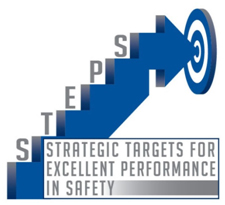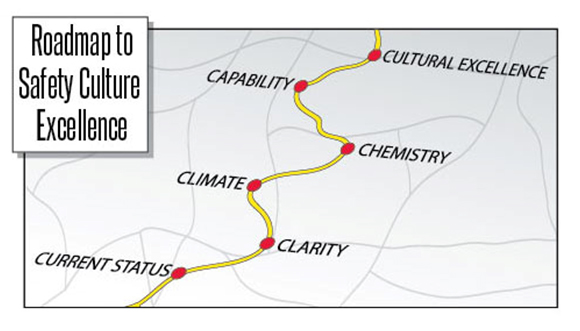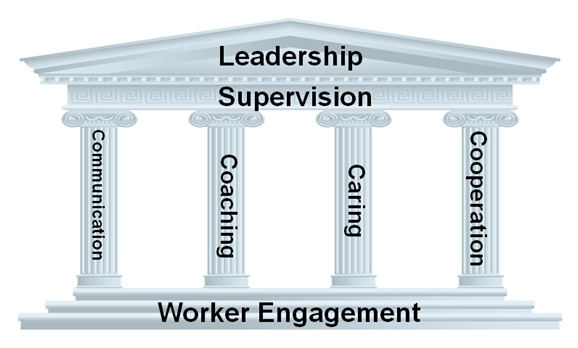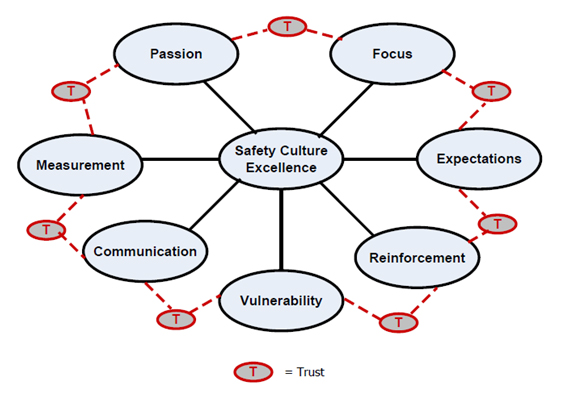Safety 2012 Proceedings - April 2012
By: Terry L. Mathis
Printable Version
EHS Today - June 2011
Printable Version
Introduction
The simple truth is that safety is not simple. It is complex and many processes we use to improve it attempt to simplify it or to address only one aspect of it. While we work on that one aspect, the others work against us. We address worker behavior but ignore the many other factors that influence behavior, from personal issues to organizational issues to the work environment itself.
We tend to blame the worker rather than fix the problem. We devise ways to improve safety culture but ignore many of the factors that influence it and wonder why we get ambushed so many times along the way. We try to instill characteristics in our safety culture but often ignore the capabilities the culture needs to continuously improve. In short, we often get the cart before the horse and try to make improvements in safety that we simply are not ready to make or sustain.
Taking it One Step at a Time
STEPS is methodical way to assess and address each of these influences and then help the organization develop the key capabilities of safety improvement. The methodology acknowledges that each culture is unique and at a different state of development. It allows you to skip steps if you already have mastered them and move on at a pace that is challenging but realistic. STEPS helps an organization to develop its own, unique personal best safety culture while carefully avoiding aiming at perfection. All too often, perfect gets in the way of good and causes leaders and organizations to become frustrated. The day-to-day goal is progress, not perfection. STEPS helps cultures move steadily and measurably toward better and more sustainable safety performance.
When you realize the enormity of a task, such as moving a safety culture toward its personal best, it can be daunting. That is why it is so important to remember the old proverb about how to eat an elephant: one bite at a time. STEPS takes an organization methodically through a set of improvement targets that, collectively, define safety culture excellence but, individually, are quite "bite" sized. This approach not only makes progress steady and doable, but actually develops a kind of organizational mechanical advantage. Just as stairs break down the task of taking your body up 10 feet against the force of gravity into a series of smaller rises that require less total force to accomplish, STEPS takes your safety culture higher and higher in a way that never requires mammoth effort (see Figure 1).

Figure 1. STEPS to Safety Culture Excellence
Marking the Path with Milestones
The journey from your current safety-culture status to your personal best is broken down into steps that lead to intermediate destinations along the way. The entire process can be mapped (see Figure 2) so no one ever feels lost or fails to see even the smallest progress toward the goal. Each step makes the organization capable of improving and/or sustaining improvement toward more excellent safety performance. Each destination marks a milestone in their progress. The final destination is more a state of capability than a set of characteristics. The goal is a "can do" culture, not simply a nice, communicative, or caring group.

Figure 2. The path to Safety Culture Excellence is a journey that should mapped.
Assessing the Culture
The starting place for the STEPS process is an assessment of the current status of the safety culture and traditional safety programs and processes. The first step of navigation is accurately determining your current position. Once you do that, you can decide which direction leads to your destination and the distance to it. Safety culture can be measured as a progression from its current state to the desired state. An accurate description of the starting status helps to better understand the length of the journey and the resources needed to complete it. The assessment can also facilitate benchmarking with other sites and industries, if so desired.
Providing Clarity
After the assessment is complete, the next set of steps is designed to lead to an intermediate destination called "Clarity". These steps are designed to get the whole organization on the same page and capable of working together as a team toward safety improvement. These steps include utilizing or developing a safety structure (safety teams, committees, etc.), reviewing the STEPS methodology and roadmap, and development and communication of definitions of basic terms such as safety, accident, precaution, near miss, condition, etc. It is amazing how many leaders and workers are not aligned on the meaning of these terms. After addressing terminology, the next steps develop a marketing plan to sell these concepts to the people in the safety culture and get them excited about making the journey to safety culture excellence together. An excellent safety culture does not begin with a modest form of "buy-in" or "participation". It begins like Black Friday with a lot of anticipation followed by a rush for the goal.
Creating a Conducive Climate
Once the organization has established clarity of purpose and method, the next steps are to fine-tune the safety "Climate". When you grow a plant, it is important to control or utilize the growing climate. You don't plant the seeds until the right time of year when there will be favorable temperatures and ample sunshine to encourage growth. The same principles are true of a safety culture. It cannot grow well in an unfavorable climate. Therefore, each step toward this destination examines and addresses (if necessary) an element of a favorable climate in which to grow an excellent safety culture. Many culture-improvement initiatives fail due to an unfavorable organizational climate. So, instead of moving forward and hoping for the best, STEPS makes sure the climate is favorable first and then grows the climate afterwards.
During the steps toward this and the next destination, the management team is asked to do some methodical soul searching and see if they meet the criteria for promoting excellence. This is difficult and challenging for some leaders and managers who have adopted other programs that deal only with the rank and file. It is even more difficult for leaders who innately blame others for organizational failures and fail to see the way their actions impact common practice.
However, excellence is not for the blind or those who cannot understand the inter-workings of organizations. Improvement is possible when only addressing some elements of the culture, but true excellence touches and is touched by every element of the organization. The journey does not demand immediate perfection or admissions of shortcomings. It slowly asks everyone to examine every aspect over time and in small bites to ensure that the way leaders lead, followers follow, and the way systems operate supports the continuous journey toward excellence.

Figure 3. The climate of Safety Culture Excellence.
Adjusting the Chemistry
The next steps are designed to align the organization's "Chemistry". Just as we strive to control the climate for our growing plant (air temperature, sunshine, rain, etc.), we also test and adjust the chemistry of the growing soil to make sure it contains the necessary and desirable elements for growth. The organizational chemistry may contain some of the elements that promote cultural excellence and also those that deplete it. The STEPS process takes each element necessary to grow an excellent safety culture and asks the organization to evaluate itself for that element. If the element is present in sufficient quantity and quality, the process moves on to the next element.
If not, there is a list of suggestions to help develop or enhance this element to a sufficient level to support the progress toward excellence. The elements suggested are among the most critical influences on organizational, and especially safety, culture. By addressing these influences systematically before moving on to cultural development, the organization can build a solid foundation upon which the safety culture can stand. Many other methods of improving safety culture try to build the culture first and then address these issues in a very reactive and inefficient way as they interfere with the process. STEPS is a way to avoid ambushes and build a more solid structure of support for the safety culture.
Now that the organization has clarity of purpose and method, a supportive climate, and the proper chemistry for growth, it is time to address the specific safety issues that remain problems to performance. The first step in this process is to accurately identify the problems. Sometimes this is as simple as a risk analysis. In other instances, multiple risks are involved in the remaining accidents, and other forms of analysis are needed. After the problems are identified and properly defined, the next task is to prioritize them. All will be addressed eventually, but it is important to begin with the right ones and progress through them in the most effective order. Many organizations have not effectively solved safety problems using the proactive tools of STEPS. It is critical that they learn to use these tools by solving their less-complex problems first and honing their skills before moving on to more difficult and complex problems. This progression also achieves some quick wins that help to motivate the process and win support from all levels of employees.
Most safety problems tend to fall into three categories: conditions, worker actions, and combinations of the two. Workplace conditions that contribute to accidents can range from simple to almost impossible to address. Even some of the simple fixes can be expensive and not in the organizational budget. Some of the more difficult issues can be engineering dilemmas, workplace design issues, or even simple space limitations. If physical changes are not possible, it is sometimes best to devise work-arounds or identify precautions that workers can take to avoid the dangers. Some accidents are best avoided by worker actions to minimize risks. These can include risks that do not involve conditional issues such as body mechanics and job coordination among workers. Other issues involve both conditions and worker actions and require more complex solutions. STEPS has methodologies to address all these issues, as well as great tools for identifying and prioritizing them.
Many other approaches jump into problem solving and ignore the organizational influences that are needed to empower and support such efforts. The STEPS methodologies make sure that these influences are addressed and that the support is there before the problem solving methodologies are put into place.

Figure 4. The chemistry of Safety Culture Excellence.
Continuous Improvement
The last STEPS destination is Continuous Improvement. The steps that lead to this destination include reassessment of the culture, succession planning for process leaders, ongoing training to address organizational turnover, professional develop for organizational and process leaders, and a continuous review of the key STEPS issues that constitute the influences and support structure for an excellent safety culture. Excellence is a journey, not a destination. Organizations that think they have arrived and cease their activities to continuously improve, begin the journey back to less-than-excellent performance.
The book entitled, STEPS to Safety Culture Excellence, will be released later this year and will have greater detail on each step and how they link together to map out the journey to this worthwhile destination.
 Terry Mathis, Founder and retired CEO of ProAct Safety, has served as a consultant and advisor for top organizations the world over. A respected strategist and thought leader in the industry, Terry has authored five books, numerous articles and blogs, and is known for his dynamic and engaging presentations. EHS Today has named him one of the '50 People Who Most Influenced EHS' four consecutive times. Business leaders and safety professionals seek Terry's practical insight and unique ability to introduce new perspectives that lead to real change. Terry can be reached at info@proactsafety.com or 800-395-1347.
Terry Mathis, Founder and retired CEO of ProAct Safety, has served as a consultant and advisor for top organizations the world over. A respected strategist and thought leader in the industry, Terry has authored five books, numerous articles and blogs, and is known for his dynamic and engaging presentations. EHS Today has named him one of the '50 People Who Most Influenced EHS' four consecutive times. Business leaders and safety professionals seek Terry's practical insight and unique ability to introduce new perspectives that lead to real change. Terry can be reached at info@proactsafety.com or 800-395-1347.
